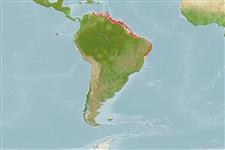Common names from other countries
>
Clupeiformes (Herrings) >
Dorosomatidae (Gizzard shads and sardinellas)
Etymology: piquitinga: Specific name probably after the `piquitinga' of Marcgraf 1648..
Environment: milieu / climate zone / depth range / distribution range
Ecologia
marinhas; estuarina; intervalo de profundidade 0 - 50 m (Ref. 188). Tropical; 13°N - 20°S, 70°W - 32°W (Ref. 188)
Western Atlantic: Nueva Esparta, Venezuela; coasts of Brazil from Racife and Lake Papary near Natal south to Bahia and Espirito Santo); probably occurring throughout northern South America (Ref. 5217).
Tamanho / Peso / Idade
Maturity: Lm ? range ? - ? cm
Max length : 15.0 cm SL macho/indeterminado; (Ref. 188); common length : 12.0 cm SL macho/indeterminado; (Ref. 188)
Espinhos dorsais (total) : 0; Raios dorsais (total) : 13 - 21; Espinhos anais: 0; Raios anais : 12 - 23. Belly sharply keeled; a well-developed first (anterior) supra-maxilla (cf. Platanichthys platana); hind border of gill opening evenly rounded; no retrorse spine on upper part of maxilla (cf. Rhinosardinia). Closely resembles the Pacific L. stolifera, but caudal fin tips not black. The very bright silver stripe along flank distinguishes it from other similar clupeids in the area.
Occurs inshore, over muddy bottoms and in brackish or hyper-saline littoral lagoons (Ref. 5217). Forms schools.
Ciclo de vida ou comportamento de acasalamento
Maturities | Reprodução | Spawnings | Egg(s) | Fecundities | Larvas
Whitehead, P.J.P., 1985. FAO Species Catalogue. Vol. 7. Clupeoid fishes of the world (suborder Clupeoidei). An annotated and illustrated catalogue of the herrings, sardines, pilchards, sprats, shads, anchovies and wolf-herrings. FAO Fish. Synop. 125(7/1):1-303. Rome: FAO. (Ref. 188)
Status na Lista Vermelha da UICN (Ref. 130435)
CITES (Ref. 128078)
Not Evaluated
Ameaça para os humanos
Harmless
Uso pelos humanos
Pescarias: pesca de subsistência; isca: usually
Ferramentas
Relatórios especiais
Baixar XML
Fontes da internet
Estimates based on models
Preferred temperature (Ref.
115969): 27 - 27.7, mean 27.4 (based on 78 cells).
Índice de diversidade filogenética (Ref.
82804): PD
50 = 0.5625 [Uniqueness, from 0.5 = low to 2.0 = high].
Bayesian length-weight: a=0.00891 (0.00507 - 0.01567), b=3.09 (2.94 - 3.24), in cm Total Length, based on LWR estimates for this species & (Sub)family-body (Ref.
93245).
Nível Trófico (Ref.
69278): 3.1 ±0.3 se; based on size and trophs of closest relatives
Resiliência (Ref.
120179): Elevada, tempo mínimo de duplicação da população menor que 15 meses (Preliminary K or Fecundity.).
Fishing Vulnerability (Ref.
59153): Low vulnerability (10 of 100).
